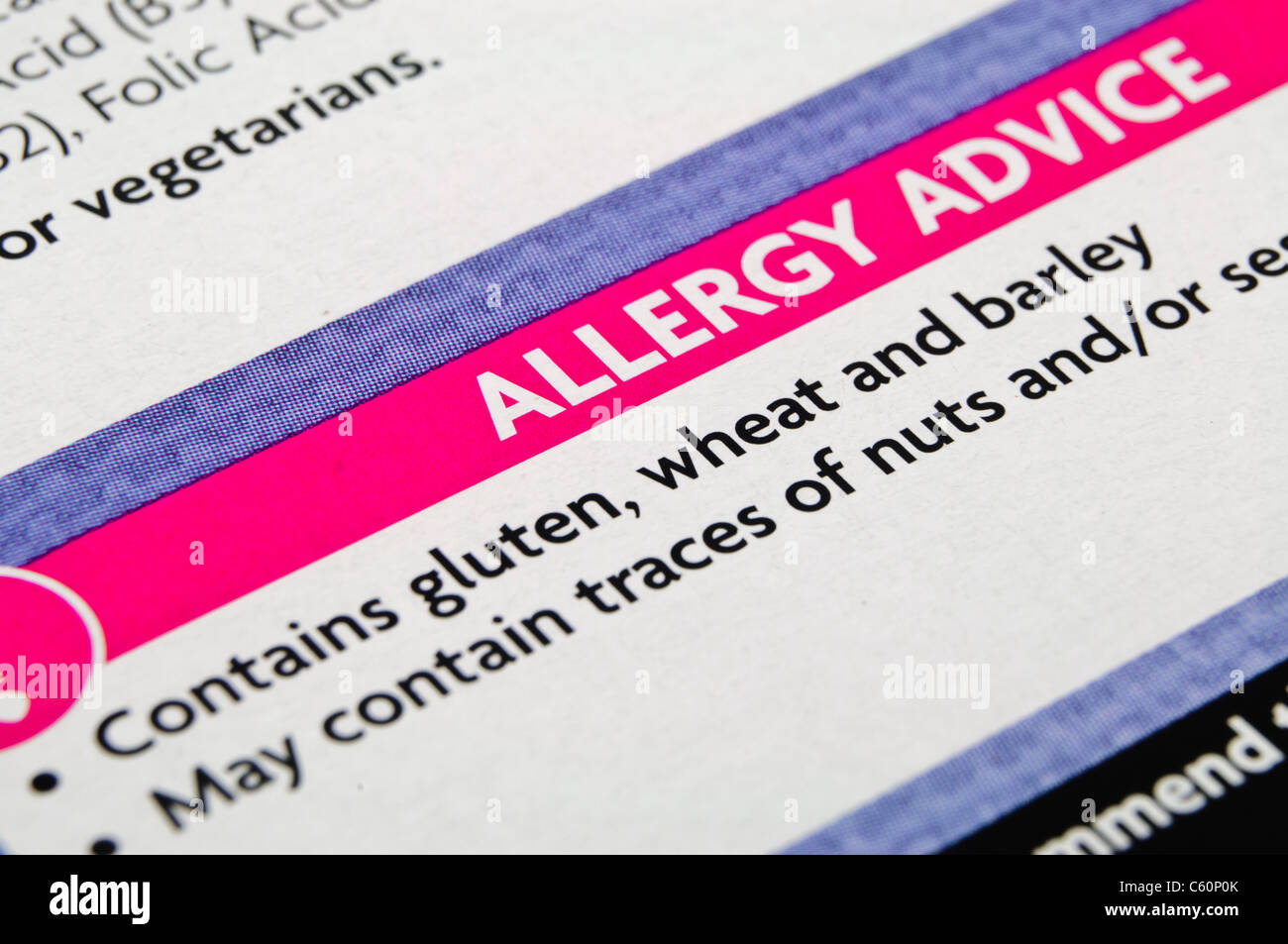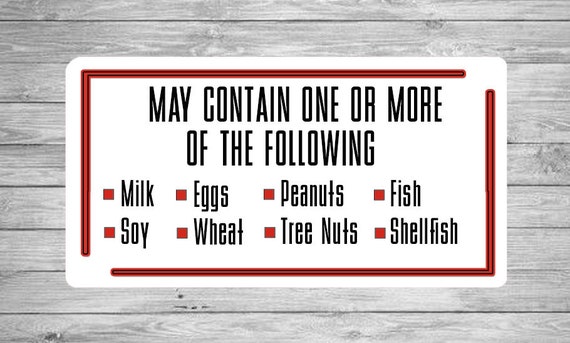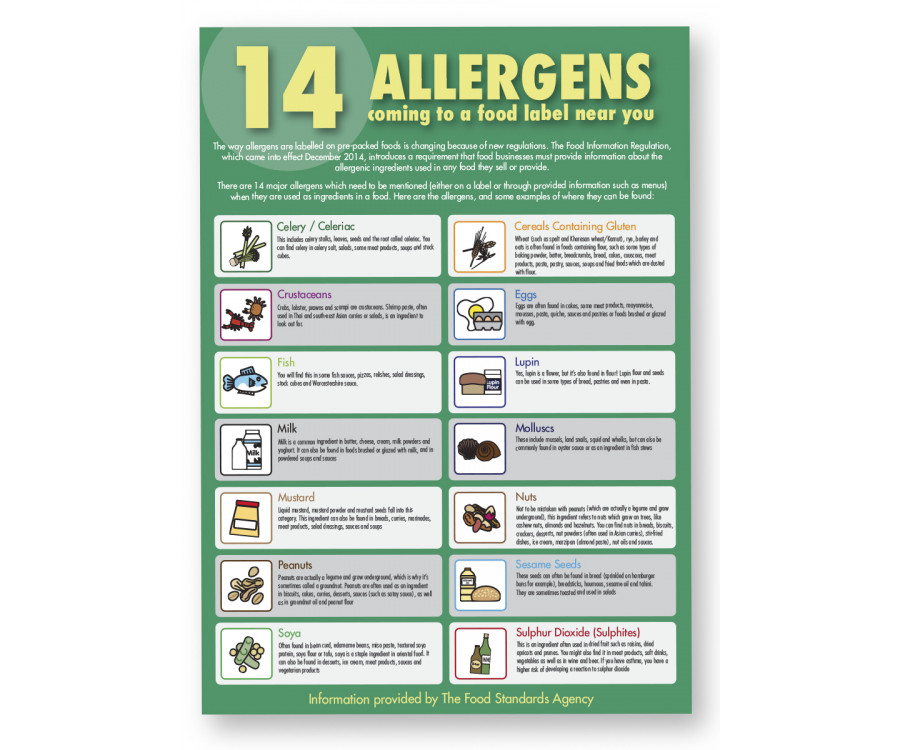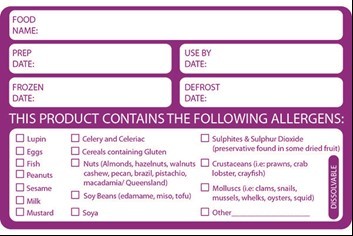42 allergens required on food labels
Food Labeling - FoodAllergy.org - Food Allergy Research & Education Food labels need to be accurate and truthful to help people with food allergies stay safe. Issues can arise when companies change the way they manufacture a food—or when they occasionally make mistakes. As of 2016, the U.S. Food and Drug Administration (FDA) has the authority to initiate allergen-related recalls. FDA: Food Labels Must List Allergens - WebMD Fish. Crustacean shellfish (like shrimp) Tree nuts. Peanuts. Wheat. Soybeans. The labeling will list these ingredients or say "contains" followed by the name of the source of the food allergen ...
Food Allergy & Anaphylaxis | Food Labeling | Food Labels Only crustacean shellfish (e.g. crabs, shrimp, lobster, or crayfish) and not mollusks (eg. clams, mussels, scallops, or squid) are required to be labeled on packaged goods. The labeling law applies only to foods regulated by the FDA.

Allergens required on food labels
PDF Food allergen labelling and information requirements FSA Food Allergen Labelling and Information Requirements: Technical Guidance - June 2020 . 9 . on food businesses to label PPDS food with a list of ingredients containing emphasised allergens bringing the provision of allergen information in line with labelling for prepacked food, reducing consumer confusion. 18. Must allergens be declared on labels? - USDA Must allergens be declared on labels? Jul 17, 2019 Knowledge Article Yes. All food products containing two or more ingredients are required by federal regulations to bear an ingredients statement listing all ingredients by common or usual name in descending order of predominance. How to Read a Food Label - FoodAllergy.org Starting Jan. 1, 2023, allergen labeling of sesame will be required under the Food Allergy Safety, Treatment, Education and Research (FASTER) Act of 2021. Ingredients and manufacturing processes can change without warning. Make a habit of carefully reading labels to ensure you avoid any potential allergens. "May Contain" Statements
Allergens required on food labels. Food Labelling for the Food Allergic Consumer | FARRP | Nebraska This means that a food ingredient which can cause a reaction in food hypersensitive consumers may be in a food without being declared on the ingredients label. To help ensure this does not happen, the Food Allergen Labelling and Consumer Protection Act (FALCPA) was passed in the U.S. in 2004. This Act requires the presence of the eight major ... TTBGov - Allergen Labeling consistent with the provisions of the food allergen labeling and consumer protection act of 2004, falcpa, the interim rule defines a "major food allergen" to mean any of the following: milk, egg, fish (for example, bass, flounder, or cod), crustacean shellfish (for example, crab, lobster, or shrimp), tree nuts (for example, almonds, pecans, or … FALCPA identifies eight foods or food groups as the major food allergens. They are milk, eggs, fish (e.g., bass, flounder, cod), Crustacean shellfish (e.g., crab, lobster, shrimp), tree nuts (e.g.,... Allergen declarations, warnings, and advisory statements on food labels ... The allergens that must be declared are: peanuts almonds Brazil nuts cashews hazelnuts macadamias pecans pine nuts pistachios walnuts crustacea molluscs fish milk egg gluten (that is found in wheat, rye, barley, oats, spelt, and triticale) wheat soy sesame lupin sulphites (must be listed if added at 10 (or more) milligrams per kilogram of food)
Food Allergen Labelling | Laws. Types Of Labels, Effectiveness There are 14 food allergens that you need to be aware of and these ingredients must be clearly marked and declared on any food offered for sale. Nuts (almonds, hazelnuts, walnuts, pecan nuts, sesame, Brazil nuts, pistachio, cashew, Macadamia or Queensland nut). Peanuts. Eggs including egg derived substances such as albumen. Milk and dairy. Allergen Labeling on Food Products - Mississippi State University Allergen declaration is required on products regulated by the Food and Drug Administration (FDA), U.S. Department of Agriculture (USDA), and state regulatory authorities (e.g., Mississippi Department of Agriculture and Commerce, Mississippi State Department of Health, Mississippi Department of Marine Resources). Food Allergen Labeling Law Requirements and Exceptions - Verywell Health Tree nuts (e.g., pecans and almonds) Peanuts Wheat, and Soybeans According to the FDA, these are the allergens that cause the most problems in the U.S. Foods that contain these allergens need to list them in the ingredients label on the package. In addition, manufacturers must use use the "common or usual name" of the allergen. Allergen Labelling Changes: Are your Labels updated ... - Food Safety Works Food allergen labeling has proven to be an effective way to prevent accidental access to potentially hazardous residues of the allergen. It is crucial for every food establishment to provide clear information about which allergenic ingredient is/are or may be present in the food product. ... The new requirements demands that allergen ...
Allergen labelling for food manufacturers 14 allergens If your product contains any of the main 14 allergens as an ingredient or processing aid, it must be included on the label. The 14 main allergens are: celery cereals containing gluten... Food Allergens - International Regulatory Chart | FARRP | Nebraska Key: 1 On April 23, 2021, sesame was added to the priority allergen labeling list (FALCPA) in the U.S. through the passing of the FASTER Act. A compliance date of January 1, 2023 has been set by Congress to allow companies to update allergen control programs and labeling requirements accordingly. Allergens- Voluntary Labeling Statements | Food Safety and Inspection ... Issue Date June 2013 This guidance document assists firms formulate voluntary labeling statements regarding the possible presence of allergens in products. Label review for meat, poultry, and egg products is required by statute at 21 USC 607 (d), 456 (c), and 1036 (b), respectively. FDA Allergen Statement Labeling: Synonyms, Species, and Types The law defines a major food allergen to mean any one of the following nine foods or food groups (or an ingredient that contains their proteins): Milk , Egg , Fish , Crustacean shellfish , Tree nuts , Wheat , Peanuts , Soybeans, and Sesame. To comply with FALCPA requirements, food packages must display allergens using their common name and list ...
Allergen labelling - Food Standards In February 2021, new plain English allergen labelling requirements were introduced for how certain foods known to be common allergens are declared. These changes will mean food allergen information is clearer and easier to find on food labels. Food businesses have three years to update their labels to meet the new requirements.
Allergen Labeling Requirements — FDA Reader Packaged foods for sale in the US which were labeled after January 1st, 2006 must have an allergen statement. This includes single-ingredient packaged foods (i.e. canned tuna) Fresh fruits and vegetables do not require an allergen statement.
Hidden Food Allergens: Are Food Labels Reliable? - WebMD The Rising Threat of Hidden Food Allergens. July 23, 2015 -- For Donna Pierre, there's no more important job than reading food labels. Her 7-year-old daughter has a life-threatening peanut ...
Allergens: Where Food Safety and Labeling Intersect In passing FALCPA, Congress noted that eight major foods or food groups—milk, eggs, fish, crustacean shellfish, tree nuts, peanuts, wheat, and soybeans—account for 90 percent of food allergies. These findings also cited a 1999 FDA review of randomly selected baked goods, ice cream, and candy showing that 25 percent of the sampled foods ...
Food Allergies | FDA Food allergies occur when the body's immune system reacts to certain proteins in food. Food allergic reactions vary in severity from mild symptoms involving hives and lip swelling to severe,...
PDF Allergen Labeling on Food Products - University of Minnesota Allergen declaration is required on products regulated by the Food and Drug Administration (FDA), U.S. Department of Agriculture (USDA), and state regulatory authorities (e.g., Mississippi Department of Agriculture and Commerce, Mississippi State Department of Health, Mississippi Department of Marine Resources).
Understanding the FDA Food Allergen Labeling Requirements - enKo Products Are We Required to List Allergens on Our Food Labels? Yes, manufacturers need to declare the presence of allergens in their product if it has any. It is required by law under the Food Allergen Labeling and Consumer Protection Act, which is simply known as "FALCPA." Food allergies occur when some types of food trigger an immune reaction.
Food Allergen Labeling: Helpful Hints To Manage "May Contain" Labeling ... Know the less common names for relevant food allergens. The eight most common food allergens are required to be listed as their common name, but less common allergens are not held to this same level of scrutiny. According to the FDA, " FALCPA identifies eight foods or food groups as the major food allergens. They are milk, eggs, fish (e.g ...
How to Read a Food Label — SPOKIN Step 1: Understand how and where to find allergen information on a label. If your allergen is a Top 8: The Food Allergen Labeling, Consumer Protection Act, requires by law, that packaged foods list an allergen in plain english if it is an ingredient. This only is required if the allergen is one of the top 8 which include peanut, tree nut, milk ...
Food Labels: Read It Before You Eat It! - American Academy of Allergy ... Ingredients of these most common eight allergens must be labeled with clearly recognized English names of the food source as listed above. The "contains" statement is "voluntary", but if used, must include ALL of the allergenic ingredients from the list of eight allergenic sources as described in item 14 of the 2006 guidance document.
How to Read a Food Label - FoodAllergy.org Starting Jan. 1, 2023, allergen labeling of sesame will be required under the Food Allergy Safety, Treatment, Education and Research (FASTER) Act of 2021. Ingredients and manufacturing processes can change without warning. Make a habit of carefully reading labels to ensure you avoid any potential allergens. "May Contain" Statements
Must allergens be declared on labels? - USDA Must allergens be declared on labels? Jul 17, 2019 Knowledge Article Yes. All food products containing two or more ingredients are required by federal regulations to bear an ingredients statement listing all ingredients by common or usual name in descending order of predominance.
PDF Food allergen labelling and information requirements FSA Food Allergen Labelling and Information Requirements: Technical Guidance - June 2020 . 9 . on food businesses to label PPDS food with a list of ingredients containing emphasised allergens bringing the provision of allergen information in line with labelling for prepacked food, reducing consumer confusion. 18.










Post a Comment for "42 allergens required on food labels"